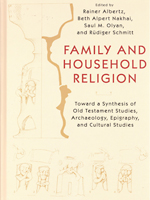Family and Household Religion in Ancient Israel and the Levant
New monograph examines varieties of domestic ritual activities in the Iron Age

A new monograph by protestant theologians Prof. Dr. Rainer Albertz and Prof. Dr. Rüdiger Schmitt from the Cluster of Excellence “Religion and Politics” examines varieties of domestic Israelite ritual activities in the Iron Age. Over the last decades, family and household religion has become a topic of Old Testament scholarship in its own right, fed by what were initially three distinct approaches: the religious-historical approach, the gender-oriented approach and the archaeological approach. The first one pursues answers to questions of the commonality and difference between varieties of family religion and describes the household and family religions of Mesopotamia, Syria/Ugarit, Israel, Philistia, Egypt, Greece and Rome. Gender-oriented approaches also contribute uniquely important insights into family and household religion. Pioneers of this sort of investigation show that, although women in ancient Israelite societies were very restricted in their participation in the official cult, there were familial rituals performed in domestic environments in which women played prominent roles, especially as related to fertility, childbirth, and food preparation. Archaeologists have worked to illuminate many aspects of this family religion as enacted by and related to the nuclear family unit and have found evidence that domestic cults were more important in Israel than has previously been understood. One might even conceive of every family as having actively partaken in ritual activities within its domestic environment. The book analyzes the appropriateness of the combined term family and household religion and identifies the types of family that existed in ancient Israel on the basis of both literary and archaeological evidence. Comparative evidence from Iron Age Philistia, Transjordan, Syria, and Phoenicia is presented. The book presents a typology of cult places that extends from domestic cults to local sanctuaries and state temples. It details the beliefs of family religion as expressed in the almost 3,000 individual Hebrew personal names that have so far been recorded in epigraphic and biblical material. The Hebrew onomasticon is further compared with 1,400 Ammonite, Moabite, Aramean and Phoenician names. These data encompass the vast majority of known Hebrew personal names and a substantial sample of the names from surrounding cultures. In this impressive compilation of evidence, the authors describe the variety of rites performed by families at home, at a neighborhood shrine or at work. Burial rituals and the ritual care for the dead are examined. A comprehensive bibliography, extensive appendixes and several indexes round out the textual material to form a one-volume compendium of Ancient Israelite Family and Household Religion in the Iron Age.
Literature: Albertz, Rainer, and Rüdiger Schmitt, Family and Household Religion in Ancient Israel and the Levant, Winona Lake (IN): Eisenbrauns 2012.

